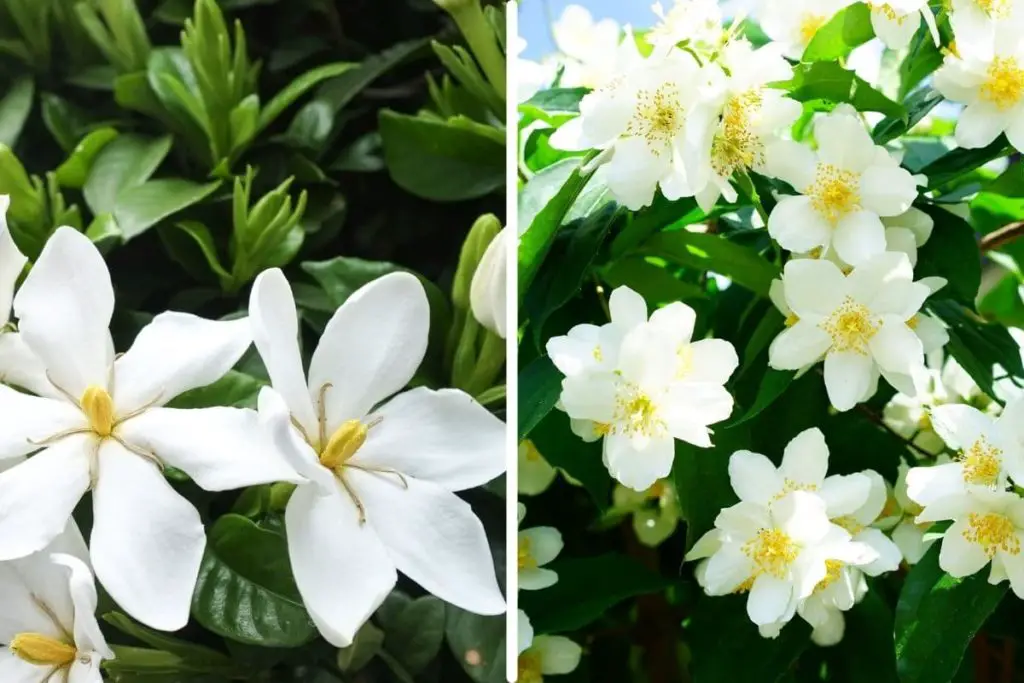People often confuse Gardenias and Jasmines because both have intense aroma and similar white flowers. However, gardenias and jasmines are different plant types, grow in different settings, and produce different smells and flowers. Here is all you need to know about the distinct features of gardenias and jasmines.
Plant Type
Gardenias are flowering, evergreen shrubs that belong to the coffee or madder family, Rubiaceae. Most varieties of gardenias grow in thick foliage and are native to Asia, Africa, Australia, and America.
The leaves of gardenias are dark green and glossy to provide a beautiful contrast to the ivory flowers.
However, some varieties of gardenia shrubs are difficult to grow outside in winter and are, instead, cultivated as house plants.
Jasmine, on the other hand, is a genus of shrubs and vines that belong to the olive family, Oleaceae. The shrubs of jasmine can be either deciduous (leaves withering in autumn) or evergreen (green leaves throughout the year).
Furthermore, some varieties of jasmines also grow as climbing or spreading vines. Jasmine flowers are most native to South and Southeast Asia. The leaves of jasmines are light-green to green in color and shorter than the gardenia leaves.
Flowers
Gardenias are subtropical flowers that bloom in warm climates throughout the year. In relatively less warm regions, gardenias usually grow in late-spring to early-summer and last till autumn.
Gardenia jasminoides, commonly called Common Gardenia or Cape Jasmine, are evergreen shrubs with dark-green leaves and intensely fragrant thick and waxy, often layered, white flowers.
Unlike gardenias, jasmine flowers are thin and contain four to five petals, usually in the shape of a star. Jasmines are white in color, although some varieties such as Asian Star jasmine and Primrose Jasmine grow pale-yellow and yellow flowers. Like gardenias, jasmines are particularly famous for their fragrance.
Jasmine are also tropical and subtropical flowers that bloom in early summer and last through the fall, with the exception of Winter Jasmine.
Winter Jasmine grows yellow flowers in early winter in deciduous shrubs and is non-aromatic. It grows near banks and provides protection against erosion.
Jasmine flowers also enjoy cultural and commercial significance. Arabic jasmine, for example, is extremely fragrant and is infused in tea.
Furthermore, jasmine garlands and bangles for women are commonly used in Asian and Arabic cultures. Other jasmine varieties are abundantly used in perfume industries and in scented candles.
Below are some of the most common gardenia and jasmine flowers:
Varieties of Gardenia:
- Cape Jasmine
Cape Jasmine is the most intensely fragrant and commonly growing variety of gardenia. Cape Jasmines grow twice a blooming season with flowers that can reach four to five inches across. These shrubs are also used for decoration purposes for weddings and anniversaries because their fragrance lingers throughout.
- August Beauty
This is another common variety of gardenia that blooms in large shrubs in early summer and sporadically through fall. This variety grows in large glossy foliage with large double flowers that reach up to three inches across.
- Kleim’s Hardy
Kleim’s Hardy is a variant of Cape Jasmine with thick, ivory flowers with bright, golden stamens. The flower contains five petals in a star shape. Kleim’s Hardy is native to southern China and Japan. These flowers can be cultivated as houseplants or cut-flowers and are especially known for their fragrance and luscious appearance.
- First Love
First love—as the name suggests—blooms earlier than any other gardenia flower (mid to late spring). The flowers of first love and waxy, showy flowers that are contrasted with dark green foliage of the shrub. The leaves of first love are dark green, glossy, and pointed at the ends.

Varieties of Jasmine:
- Common Jasmine
Common jasmine is an intensely fragrant type of jasmine, sometimes referred to as poet’s jasmine. These grow on tall climbing vines and are preferred on entryways and archways. Common jasmine can be found abundantly in Asia that bloom in late spring to early summer and into the fall.
- Spanish Jasmine
Spanish jasmine is another type of jasmine grown on vines and is one of the most cultivated varieties of jasmine. It grows in evergreen vines in temperate climates, and on deciduous vines in cooler regions. Spanish jasmine is also known as Catalonian or royal jasmine.
- Arabic Jasmine
Arabic jasmine is a showy, layered white flower that is extremely fragrant and grows on evergreen shrubs. This type of jasmine has cultural significance and is enjoyed infused in tea.
- Primrose Jasmine
Primrose jasmine is a variant of jasmine that grows bright yellow flowers in climbing shrubs. Primrose jasmine is native to China and blooms in late-winter to spring amidst a shrub of dark green, trifoliate leaves.
- Angel Wing Jasmine
Angel wing jasmine grows in spreading shrubs. Also known as shining jasmine, angel wing jasmine has nine to ten large, thin white petals with a light purple underside. These flowers can be used as cut-flowers or put in containers as fillers to grow between shrubs.
How to Grow Gardenias:
Gardenias are tropical and subtropical evergreen shrubs that can be cultivated as houseplants to diffuse intense aroma throughout the home.
Here are all the things you require to grow your own creamy, waxy gardenia flower:
- Gardenias enjoy full sun, especially in the winter. In warmer climates, a little afternoon shade may be preferred preceded by a full sun in the morning. However, too much sun in hot temperatures can cause the leaves to scorch and turn yellow or brown.
- Gardenia flowers bloom the best in damp, acidic, and organic soil. Ensure that the pH of the soil remains between 5 and 6, and that it is always moist and well-watered, not soggy or over-flowing. Add organic mulch or manure to the soil to give your flower growth a boost.
- Gardenias thrive in humid environments! If you are growing gardenias indoors, you may use a humidifier. Otherwise, you may also use water-spray on the flowers and leaves regularly to ensure that they remain humid and keep away any bugs that are attracted to dryness.
- The growing season of gardenia is early to mid-spring and into the fall. Gardenias need fertilization every 2-4 weeks during the growth season to ensure healthy growth. Do not fertilize outside of the growth season.
- Gardenias require pruning/shaping when they are latent to enhance branching and development.
How to Grow Jasmines:
Jasmines, like gardenias, are tropical and subtropical plants that effuse intense aroma. Jasmines are most prized as climbing and spreading vines, and can easily be cultivated as houseplants.
Here’s everything you need to know about growing jasmines in your own house:
- Summer blooming jasmine, like common and Arabic jasmine, requires full sun to bloom fully. While other jasmine varieties such as Winter jasmine, thrive in partial shade in the afternoon.
- The preferred soil for planting jasmines is well-drained and moist. In hotter regions, the soil must be frequently watered but left to dry between intervals. The type of soil best for jasmine growth is sandy and loamy in nature.
- Jasmine vines like to climb tall! Support the vine by a trellis or a fence and train the vine by loosely passing it through a trellis and gently tying. Furthermore, do not plant it too deeply in the soil, since the vine’s natural habitat is in climbing and spreading. Let its wings (leaves) fly!
- Regular pruning of jasmine vines help them flower more frequently and maintain a thick, active foliage. Check for any dead stems or stems that are growing away from the plant. Cut any tangled or damaged stems and maintain the trained plant. It is preferable to prune jasmine blooms immediately after they blossom for rapid growth of the vine.
Conclusion
Most people often ask which of the two flowers smells better—jasmine or gardenia. There is no correct answer. Both the flowers effuse intense and distinguished fragrance that can easily entice any flower-lover. Like any other plant, gardenias and jasmines require specific care and attention to grow and thrive in their cultivated environments.
